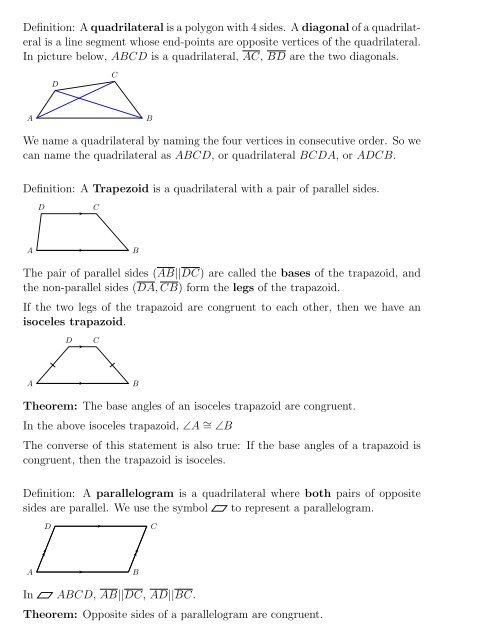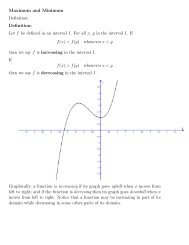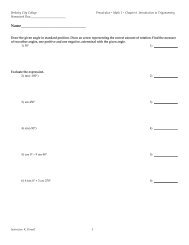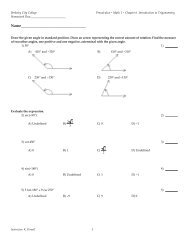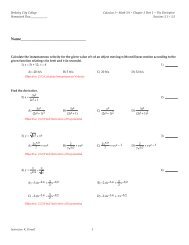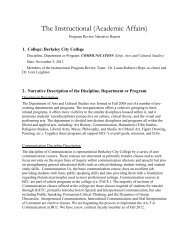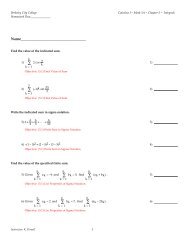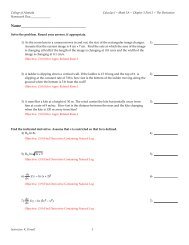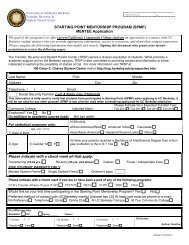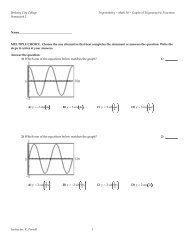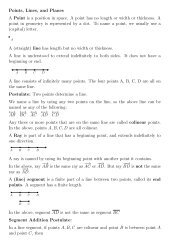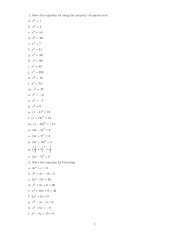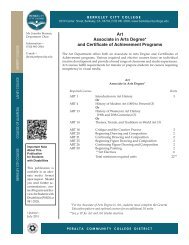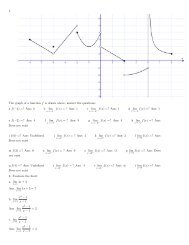Parallelogram - Berkeley City College
Parallelogram - Berkeley City College
Parallelogram - Berkeley City College
You also want an ePaper? Increase the reach of your titles
YUMPU automatically turns print PDFs into web optimized ePapers that Google loves.
Definition: A quadrilateral is a polygon with 4 sides. A diagonal of a quadrilateral<br />
is a line segment whose end-points are opposite vertices of the quadrilateral.<br />
In picture below, ABCD is a quadrilateral, AC, BD are the two diagonals.<br />
D<br />
C<br />
A<br />
B<br />
We name a quadrilateral by naming the four vertices in consecutive order. So we<br />
can name the quadrilateral as ABCD, or quadrilateral BCDA, or ADCB.<br />
Definition: A Trapezoid is a quadrilateral with a pair of parallel sides.<br />
D<br />
C<br />
A<br />
B<br />
The pair of parallel sides (AB||DC) are called the bases of the trapazoid, and<br />
the non-parallel sides (DA, CB) form the legs of the trapazoid.<br />
If the two legs of the trapazoid are congruent to each other, then we have an<br />
isoceles trapazoid.<br />
D<br />
C<br />
A<br />
B<br />
Theorem: The base angles of an isoceles trapazoid are congruent.<br />
In the above isoceles trapazoid, ∠A ∼ = ∠B<br />
The converse of this statement is also true: If the base angles of a trapazoid is<br />
congruent, then the trapazoid is isoceles.<br />
Definition: A parallelogram is a quadrilateral where both pairs of opposite<br />
sides are parallel. We use the symbol to represent a parallelogram.<br />
D<br />
C<br />
A<br />
B<br />
In<br />
ABCD, AB||DC, AD||BC.<br />
Theorem: Opposite sides of a parallelogram are congruent.
Proof: Given ABCD, we must prove that AB ∼ = DC and AD ∼ = BC. We<br />
contruct the diagonal, AC, of the parallelogram.<br />
D<br />
C<br />
A<br />
B<br />
Statements<br />
Reasons<br />
1. AC is a diagonal to ABCD 1. Given<br />
2. AB||DC, AD||BC 2. Def. of<br />
3. ∠DCA ∼ = BAC, ∠DAC ∼ = ∠BCA 3. Alternate Interior angles<br />
4. AC ∼ = AC 4. Reflexive<br />
5. △CAB ∼ = △ACD 5. ASA<br />
6. AB ∼ = CD, AD ∼ = CB 6. CPCTC<br />
The converse of this statement is also true. That is, if both pairs of opposite<br />
sides of a quadrilateral are congruent, then the quadrilateral is a parallelogram.<br />
Theorem: The diagonals of a parallelogram bisect each other.<br />
Proof: Given ABCD, let the diagonals AC and BD intersect at E, we must<br />
prove that AE ∼ = CE and BE ∼ = DE.<br />
D<br />
C<br />
E<br />
A<br />
B<br />
Statements<br />
Reasons<br />
1. AC and BD are diagonals to ABCD 1. Given<br />
2. AB||DC, AD||BC 2. Def. of<br />
3. ∠DCE ∼ = BAE, ∠CDE ∼ = ∠ABE 3. Alternate Interior angles<br />
4. DC ∼ = AB 4. opposite sides of are ∼ =<br />
5. △ABE ∼ = △CDE 5. ASA<br />
6. AE ∼ = CE, BE ∼ = DE 6. CPCTC<br />
7. AC, BD bisect each other 7. Def. of segment bisector<br />
The converse is also true: If the diagonals of a quadrilateral bisect each other,<br />
then the quadrilateral is a parallelogram.
Theorem: Opposite angles of a parallelogram are congruent to each other. In<br />
ABCD, ∠A ∼ = ∠C, and ∠B ∼ = ∠D.<br />
D<br />
C<br />
A<br />
B<br />
Conversely, if both pairs of opposite angles of a quadrilateral are congruent to<br />
each other, then the quadrilateral is a parallelogram.<br />
A rectangle is a parallelogram with all four angles being right angles. In a<br />
parallelogram, if one angle is a right angle, then all four angles are right (why).<br />
D<br />
C<br />
A<br />
B<br />
ABCD is a rectangle.<br />
Theorem: The two diagonals of a rectangle are congruent.<br />
D<br />
C<br />
A<br />
B<br />
In rectangle ABCD, AC ∼ = BD.<br />
A rhombus is a parallelogram with all four sides congruent to each other.<br />
D<br />
A<br />
C<br />
B<br />
ABCD is a rhombus, which means AB ∼ = BC ∼ = CD ∼ = DA. A rhombus has a<br />
diamond-like shape.<br />
Theorem: The diagonals of a rhombus are perpendicular to each other.
Proof: Given rhombus ABCD, let the diagonals AC, BD intersect at E, we must<br />
prove that AC ⊥ BD<br />
D<br />
A<br />
E<br />
C<br />
B<br />
Statements<br />
Reasons<br />
1. AC and BD are diagonals to rhombus ABCD 1. Given<br />
2. AB ∼ = BC 2. Def. of rhombus<br />
3. AE ∼ = CE 3. Diagonals of bisect each other<br />
4. BE ∼ = BE 4. Reflexive<br />
5. △BAE ∼ = △BCE 5. SSS<br />
6. ∠BEA ∼ = ∠BEC 6. CPCTC<br />
7. AC ⊥ BD 7. Def. of perpendicular lines<br />
A square is a parallelogram with four congruent sides and four right angles. In<br />
other words, a square is a rectangle and a rhombus.<br />
D<br />
C<br />
A<br />
B<br />
ABCD is a square, which means that ∠A, ∠B, ∠C, and ∠D are all right angles.<br />
In addition, AB ∼ = BC ∼ = CD ∼ = DA<br />
Understand that rectangles, rhombus, squares are all parallelograms. Therefore<br />
they all have properties that a parallelogram has. Any theorem that is true about<br />
a parallelogram can be applied to a rectangle, rhombus, or square. These special<br />
parallelograms, of course, have more specific properties that may not be shared<br />
by other parallelograms. We use a table to indicate the properties that are true<br />
for each kind of figure:
Properties <strong>Parallelogram</strong> Rectangle Rhombus Square<br />
Opposite sides Parallel yes yes yes yes<br />
Opposite sides Congruent yes yes yes yes<br />
Diagonals bisect each other yes yes yes yes<br />
Opposite angles are congruent yes yes yes yes<br />
Diagonals are congruent no yes no yes<br />
All four angles are right no yes no yes<br />
Diagonals are perpendicular no no yes yes<br />
All four sides congruent no no yes yes<br />
To prove that a parallelogram is a rectangle, we need to prove that one of its<br />
interior angle is right. We can also try to prove that its diagonals are congruent.<br />
To prove that a parallelogram is a rhombus, we need to prove that its four sides<br />
are congruent. We can also try to prove that its diagonals are perpendicular.<br />
To prove that a parallelogram is a square, we need to prove that it is a rectangle<br />
and a rhombus.<br />
Theorem: If three or more parallel lines cut off congruent segments on one<br />
transversal, then they cut off congruent segments on all other transversals.<br />
In picture below, AB||CD||EF . If HG is a transversal cutoff into equal parts by<br />
the three parallel lines, then KJ will also be cut-off into equal parts by the three<br />
parallel lines.<br />
H<br />
K<br />
E<br />
F<br />
A<br />
C<br />
D<br />
B<br />
G<br />
J<br />
Proof: In the picture below, given lines AB||CD||EF , and LM ∼ = MN, we need<br />
to prove that RQ ∼ = P Q. We will do so by introducing a new line, the line<br />
through Q parallel to HG.
H<br />
K<br />
E<br />
N<br />
R<br />
V<br />
F<br />
C<br />
M<br />
Q<br />
D<br />
A<br />
L<br />
T<br />
P<br />
B<br />
G<br />
J<br />
Statements<br />
Reasons<br />
1. AB||CD||EF , LM ∼ = NM 1. Given<br />
2. Construct V T through Q parallel to LN 2. Parallel Postulate<br />
3. NMQV and MLT Q are parallelograms 3. Def. of <strong>Parallelogram</strong>s<br />
4. MN ∼ = QV , LM ∼ = T Q 4. Opposite sides of are ∼ =<br />
5. V Q ∼ = T Q 5. Substitution<br />
6. ∠RV Q ∼ = ∠P T Q, ∠V RQ ∼ = ∠T P Q 6. Alternate Interior Angles<br />
7. △RV Q ∼ = △P T Q 7. AAS<br />
8. RQ ∼ = P Q 8. CPCTC<br />
Theorem: If a line is drawn from the midpoint of one side of a triangle and<br />
parallel to a second side, then that line bisects the third side.<br />
In picture below, M is the midpoint of AB. If we construct a line through M<br />
parallel to AC, then this line will intersect BC at N, where N is the midpoint<br />
of BC<br />
B<br />
M<br />
N<br />
A<br />
C<br />
The converse of this theorem is also true. If a line connects the midpoints of two<br />
sides of a triangle, then the line is parallel to the third side. In addition, the<br />
length of this line is half of the length of the third side.<br />
In the picture above, if M is the midpoint of AB and N is the midpoint of CB,<br />
then MN||AC, and MN = 1 2 AC<br />
Theorem: The three medians of a triangle intersect at a point (the centroid<br />
of the triangle). This point is two-thirds of the distance from any vertex to the
midpoint of the opposite side.<br />
B<br />
E<br />
F<br />
M<br />
A<br />
D<br />
C<br />
In the above, if AF , CE, and BD are medians of △ABC, then they intersect at<br />
a single point, M, and CM = 2ME, AM = 2MF , BM = 2MD.


